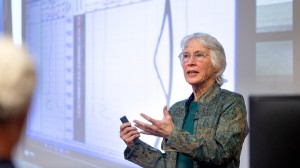From an Article by Blaine Friedlander, Cornell Chronicle, November 8, 2022
Nearly 175 community members joined a town forum Nov. 3, held in person and online, to hear updates on the Cornell University Borehole Observatory – known as CUBO. The observatory represents a major step toward achieving viability for the university’s Earth Source Heat (ESH) project to warm the Ithaca campus without the use of fossil fuels.
The university drilled a nearly 2-mile deep borehole, located on a Cornell-owned gravel parking lot near Palm Road, over the summer and has since been conducting tests and analysis. The drilling operations concluded Aug. 13.
Opening the forum Lynden Archer, the Joseph Silbert Dean of Engineering and co-chair of the Sustainable Cornell Council, which manages the ESH project, said that it will take time to analyze data from the site, as campus engineers and industry partners examine the figures to determine the feasibility of designing and building a functioning two-well demonstration project.
“I must say that I’m personally pleased,” Archer said, “to report that the early data garnered from CUBO are promising.” The observatory will also be useful for deep-earth research beyond CUBO, Archer and others said.
Five expert panelists – moderated by Rick Burgess, vice president for facilities and campus services, and co-chair of the Sustainable Cornell Council – presented details about the borehole drilling process and safety, seismic monitoring, geologic layer predictions, hydrogeology and temperature, as well as the project’s possible next steps.
Teresa Jordan, the J. Preston Levis Professor of Engineering Emerita and co-principal investigator of the borehole project, said the group found three prospective target zones for which to infuse water deep into the Earth. During the program, panelists explained that water will flow through fractures in Earth-heated rocks, and then a second well will extract it as hot water. Once the hot water returns to the surface, it will go through a heat exchanger to be circulated through the campus’ existing district heating system. The original water is returned to the subsurface, where it warms back up and begins the cycle again.
Jordan and her colleagues said the borehole’s design – with its cement casing – lined up quite well with the predicted geologic layers that the scientists encountered. “When it comes to designing future wells for a resource-heat demonstration project,” she said, “we now have excellent knowledge of how to design and how to budget for the wells – because we have this [borehole] experience.”
Patrick Fulton, the David Croll Sesquicentennial Fellow and assistant professor in the Department of Earth and Atmospheric Sciences, said that temperatures at the bottom of the borehole reached about 82 degrees Celsius, consistent with the 80- to 90-degree C target that project geologists sought. In a few weeks, Fulton said, fiber-optic cables and sensors will be installed at the borehole to understand temperatures at different depths over time.
Geoff Abers, the William and Katherine Snee Professor in Geological Sciences, and the chair of Earth and Atmospheric Sciences, reported that no seismic activity related to the drilling was recorded, confirming the testing his team has been conducting in the area since 2019. Abers said the findings were consistent with expectations. “We didn’t actually see anything unusual there,” he said, “because all that’s really happening is we’re drilling and pulling knowledge out of the hole.”
To provide context on the CUBO site selection process, Cornell geologist Ole Gustafson, Ph.D. ‘20, of Facilities and Campus Services, spoke for a few minutes and reviewed the safety and environmental considerations for the borehole site. The 4-acre parking lot site for CUBO was ideally suited for the drilling rig. While it was adjacent to campus, it was not close to sensitive research facilities or residential areas, Gustafson said. The rig’s operation used electricity – provided by the campus grid – nixing the need for power generators.
In his talk, Jeff Tester, the David Croll Sesquicentennial Fellow and professor in the Smith School of Chemical and Biomolecular Engineering and principal investigator for the project, displayed a United States map to underscore how New York, New England and the country’s northern tier depend on carbon-based fuel to heat homes and businesses.
In New York state, for example, Tester said, about 40% of its carbon footprint comes from burning fossil fuels to generate steam or hot water or hot air – at end-use temperatures between about 100 and 230 degrees Fahrenheit – for heating buildings and providing industrial-process heat. “Almost all of [our heat] comes from combustion-based processes that involve natural gas, and to some extent oil in the northeast, and sometimes propane,” Tester said. “If we’re going to transition [to] a low-carbon future, we’re going to have to do something about that.”
Tester said most places in the U.S. do not have district heating, which is a localized, efficient network to distribute heat from a central source. Fortunately, Cornell uses district heating to warm campus, he said, and the university represents a logical place to carry out a demonstration.
Explaining that the geology has ample heat in the rock below campus, the scientists now need to demonstrate water flow with a well pair to determine if the economics for the project are reasonable. Said Tester: “We still have to validate a lot of this stuff at a scale that’s going to be needed to extract heat. Currently, the borehole is capped – lightheartedly nicknamed by officials as the “Big Red Fire Hydrant” – and designated now for future faculty and student research use.

